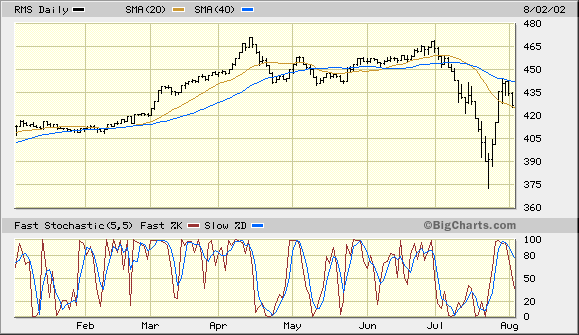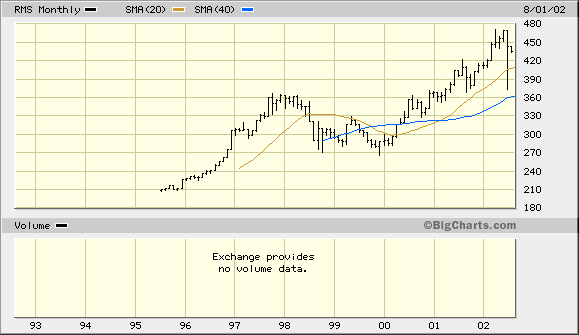Real Estate Crash Update
Many investors have asked where has Alan Greenspan and his Federal Reserve and so-called "Plunge Protection" team been all through the current traumatic year? His presence was never-failing throughout crisis times in the '80s and '90s, yet there has been no evidence of inside support of the stock market the entire year during panic phases. While Greenspan and Co. have been nowhere near the equities arena, we have a good idea where they have concentrated most of their attention-the real estate market, also known as the final straw on the camel's back.
The market for real estate equities (REITs) is not the blithe, optimistic outlook it was at the beginning of the year. Since double topping at the beginning of July, the REIT sector has sold off and retraced all their year-to-date gains. A rally off the mid-July lows has propelled the leading indicator of this sector, the Morgan Stanley REIT index (RMS), to a 75% retracement of its previous decline but the rally has stalled out and now appears to be headed down again. A break below immediate support at 425 in this index (the 20-day moving average) will confirm the next leg down is underway in REITs. Another indication that this sector is headed downward is due to the fact that the previous rally was a classic low-volume rally, which indicates short covering and not support buying. And as we've seen many times this year, short covering rallies never last long and always retrace their previous gains. See the chart on the newsletter page at the Internet link above. Even worse, check out the extremely bearish formation and confirmed top in the 10-year monthly chart of RMS.


You can see Greenspan's (and his cohorts) interference with this market in the massive reversal rally in July. This is precisely the type of market reversal we saw every time the Fed was involved with a financial market in the '90s and it is now showing up in the REITs. Yet this time it is of no avail as the crushing weight of the long-term cycles will collapse even the real estate market along with everything else in its path.
What we've witnessed so far in 2002 is the systematic breakdown of virtually every major financial sector and paper asset. We've seen the dollar collapse, the breakdown of the blue chip stocks, and the deterioration of the U.S. economy. What we have not yet seen is the breakdown of the real estate market, the proverbial "last Indian standing." It is typical, due to its nature, for real estate to be the last thing to breakdown in a long-term bear market such as we are now in. Predicting the timing of a real estate crash is very hard to do since they can be prolonged, but rest assured it is coming. We've followed the progression of the real estate bubble since late last year and will continue to update it as the year progresses.
One thing is certain, however, and that is that the REITs tend to lead the trend in the physical real estate market. Already we see the preliminary sign that the bubble in real estate values is close to popping since the REIT bubble has already popped and is rapidly being deflated. If we had to predict, we would expect to see a noticeable slow-down in the national average property sales by year's end. Housing starts have already started declining and most of the "boom" phase of the home building mania is over. All that remains is for mainstream America to realize that in a prolonged liquidation market and falling economy, even the so-called "last resort" of real estate as an investment will not survive the crash but must be sold to meet demands for debts and obligations elsewhere, not to mention a lack of demand in home buying.
Although we are by no means experts in real estate, we have observed an interesting trend in coastal real estate values and market trends on the island in which we live here in North Carolina. Following the WTC bombing and stock market crash last September, there was a panic "freeze" on home building here on the island and in surrounding areas. Homes that had started to be built from the ground up were literally abandoned for several months before homebuilding picked up again with a vengeance this past winter and into spring. It was almost as if builders were making up for the lost time due to the Sept. 11-related shell shock. Everyday for weeks hammers and saws could be heard from dawn to dusk even in the cold of winter as an unprecedented explosion in new home building commenced. Most of these homes were built on "spec," that is, speculative house building under the assumption that "if we build it, the buyers will come." But an interesting thing happened. In the early phase of this boom, there were in fact buyers. But as the year has progressed and market conditions have worsened, there seem to be less and less buyers and a number of recently-built houses with "For Sale" and "Price Reduced" signs are still up with no takers, very unusual for prime beachfront real estate in this neck of the woods.
What happens when the current spate of long-term investment liquidations runs its course and Americans realize that even by selling everything they still don't have money enough to meet all their obligations. Most are mortgaged to the hilt, and with stocks and the economy in rapid decline (not to mention the tenuous job market), there will soon be the problem of meeting the monthly mortgage payment. That much you can count on. To make matters worse, and as if Americans haven't already learned the lessons from the '80s and '90s debt binge, there have been a recent flood of loan offers going out to cash-strapped home owners that will prove too tempting to resist as a way to "meet those monthly payments." Unfortunately, this will only increase the already crushing debt load on the backs of most Americans. By the way, this proves that we are nowhere near a bottom since lending institutions are still in a generous mood and there are still takers. You know the final bottom is in when there is a unanimous revulsion to debt and when loans are scarce and takers are even fewer.
Americans (particularly those nearing retirement) are funneling all of their investment capital into real estate under the false assumption that real estate will always be in heavy demand and that property values will always rise. This is a holdout from that fallacious thinking that has already been responsible for the loss of trillions of dollars in capital, viz., "buy and hold for the long-term no matter what happens." Americans have discovered the hard way that this mantra is not true for stocks and they are about to discover that it doesn't apply to real estate, either.
















